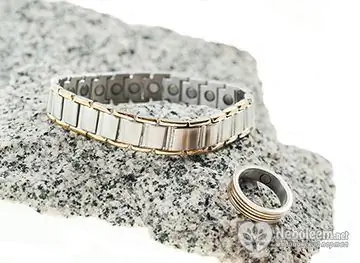- Author Rachel Wainwright [email protected].
- Public 2023-12-15 07:39.
- Last modified 2025-11-02 20:14.
Electrolysis

Electrolysis is one of the methods for the complete removal of body hair. Epilation is performed using electrical discharges, which are directed into the follicles using electrodes with fine needles. Under the influence of an electric current, the hair follicle is destroyed, and the hair stops growing.
Types of electrolysis
Today electrolysis is carried out in five ways: electrolysis, thermolysis, Blend, Flash, tweezers.
Electrolysis involves the use of low voltage direct current. Under its influence, sodium hydroxide is formed around the hair follicle, which destroys it.
The procedure is painful, after it redness may remain on the skin.
Experts resort to electrolysis hair removal only if a small area of the skin needs to be treated, since the procedure is quite long.
Thermolysis, unlike electrolysis, is carried out using high frequency alternating current. In this case, the effect of hair removal is due to the fact that the bulbs are heated and destroyed.
Thermolysis acts faster - hair is removed in 2 seconds, in one session you can remove a third of unwanted hair.
The disadvantages of electrolysis, which is carried out by the method of thermolysis, are that it does not make it possible to remove hair with a curved root and that it is painful. There are reviews about electrolysis by thermolysis, indicating that after the procedure, burns may remain on the skin.
The Blend method works simultaneously on the principle of thermolysis and electrolysis. Hair is removed on average in 10 seconds, but the sensations are not so painful, and there is an opportunity to remove hairs with curved roots.
The Flash method is based on the use of a high-frequency discharge with a long pulse duration. The method allows you to reduce pain, but discomfort is still felt.
Tweezer hair removal is the removal of hairs using tweezers-shaped electrodes. A high-frequency electric current is used here. The method works like this: grab the hair with tweezers and deliver a discharge through it.
The advantage of the method is that the electrode does not come into contact with the skin, therefore, the risk of burns and irritation is reduced. The method is used most often for hair removal in areas where the skin is especially sensitive.
Reviews of electrolysis indicate such disadvantages of the method: the bulbs do not completely collapse the first time, the procedure has to be repeated more than 5 times. In this case, it takes about 30 seconds to act on one hair.
There is another concept called scan hair treatment. It is sometimes referred to as electrolysis, but this is incorrect, although electric current is also used here. The point of the procedure is that the hair is treated with solutions that reduce their growth, after which it is exposed to an electric current - this way the funds penetrate better into the hair roots.
If you go through several such scan treatments, then you can achieve the fact that the hair will gradually thin out and stop growing. In some salons, scan processing is carried out simultaneously with electrolysis or thermolysis.
In which areas can you remove hair with electrolysis
Most often, electrolysis is performed on the face and legs. In addition, this method can be used to remove hair on the hands.

In the groin (bikini electrolysis), under the armpits, on the chest, it is not recommended to remove hair using an electric current, since in these areas the lymph nodes are located quite close to the skin surface. Nevertheless, salons actively practice electrolysis of bikini and armpits, reassuring their visitors that the depth of exposure to electric current is not so great as to affect the lymph nodes.
Do's and don'ts after electrolysis
After electrolysis, the treated area should not be moistened with water during the day. Until the skin heals after the procedure, it is recommended to use special treatment products. Usually they are recommended by the master who performed the epilation, taking into account the peculiarities of the skin, the degree of trauma, etc.
It is undesirable to sunbathe in the sun or in a solarium after electrolysis - this can injure the skin and cause the appearance of age spots. You cannot swim in open water bodies, the sea, the pool, or visit the bathhouse.
Do not touch the treatment area with dirty hands. Underwear and clothes, if body hair was removed, it is advisable to wear loose cut from natural materials.
Reduce physical activity, as excessive sweating will make the skin slower to heal.
These restrictions apply only to the recovery period. It lasts an average of a week.
Also, if electrolysis was performed on the face, it is important to know that the first day will have to do without decorative cosmetics.
Many people wonder if after electrolysis it is possible to apply other methods of complete hair removal or depilation (shaving, treatment with depilatory creams). Experts recommend not using other methods of getting rid of unwanted hair. That is, for example, if electrolysis was carried out on the face, but the result was unsatisfactory, it is advisable to consult with a specialist and apply another method of electrolysis, but not try to shave or pull out the hairs yourself.
Contraindications for electric hair removal
Do not remove hair by electrolysis if you find:
- phlebeurysm;
- infection;
- heart diseases;
- acute, chronic skin diseases;
- pustules, skin inflammation;
- poor blood clotting;
- oncological diseases;
- epilepsy;
- diabetes mellitus in decompensated stage;
- individual current intolerance;
- hepatitis.
Also, you cannot carry out electrolysis for pregnant women, lactating women, those who have an intrauterine device (if we are talking about electrolysis of a bikini), as well as people with a pacemaker.
Found a mistake in the text? Select it and press Ctrl + Enter.






